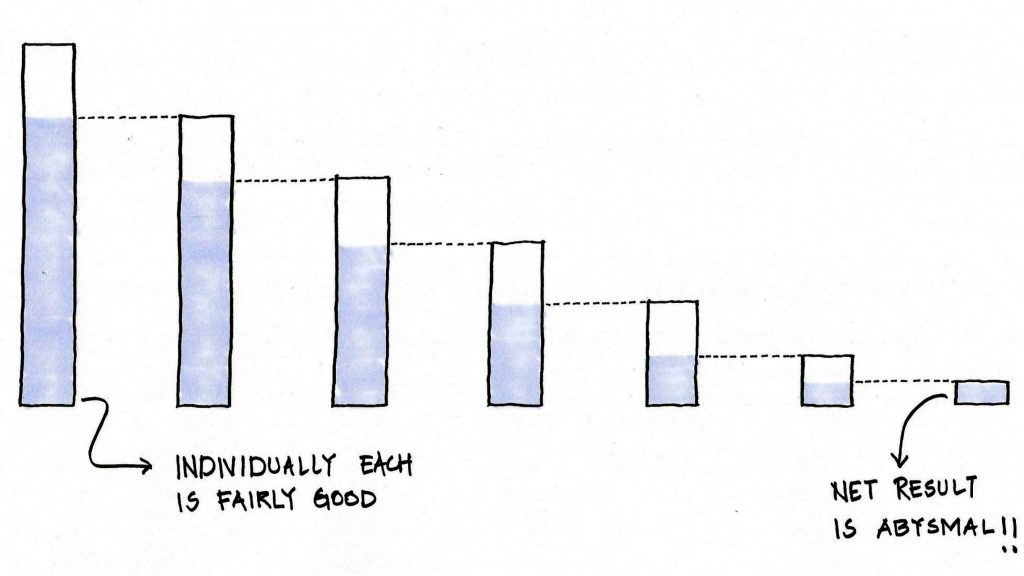One of the most influential essays for me in starting a business, was this early article by Steve Pavlina. In the essay, he argues that building a successful company comes from a combination of factors (product quality, market demand, sales copy, etc.):
“And let’s say that for each factor there is a range of effectiveness from 0% to 100%.
Understand this: these factors don’t add — they multiply! If all of your critical factors are at 100%, but just one is at 0%, that means you could be getting zero sales, even though you did most things perfectly. For instance, you could have a truly brilliant product, but if people don’t feel secure using your order form, that single flaw could cost you most of your potential sales.” [emphasis in original]
This multiplicative model is obviously a simplification of how a business works. However, it is also a powerful idea because it shows how small improvements could add up and why doing a bunch of things well, but not great, could still lead to lousy results.
With my own business, for instance, there are several factors which clearly multiply. To make revenue from this blog, I need to have traffic, conversion of traffic to readers, a product which addresses a problem people have and belief from readers that I can actually help with said problem.
If any of these factors do poorly, the business as a whole does poorly. Many people I know in this industry suffer because one or more of their links in the chain is weak. I have some friends with a great pitch and product, but they don’t have traffic so they have no business. I have other friends with lots of readers, but their product isn’t compelling enough and they struggle with money.
It took me around seven years to get all the pieces working sufficiently to earn a living. Even a doubled improvement of one factor (no small feat) doesn’t add up to much when the total is low. Two multiplied by $100 is only $200.
Yet, when you get the factors working together, improvements have a much larger base to build upon. Two multiplied by a million dollars is two million dollars.
When Do Things Multiply? When Do They Add?
Although building a business is a salient example of multiplicative factors, there are many other situations where this can happen.
Complex skills like painting or chess have key factors that multiply. Painters must know color mixing, drafting, composition and brushwork. Chess players must know openings, endings, strategy and tactics. A deficiency in any factor can be the difference between amateur and professional.
However, many other factors don’t multiply—they add. These factors are great to have, but they also don’t mean doom if they’re missing. Each word learned in a new language, for instance, has a roughly additive effect on your speaking ability, proportional to its frequency. More useful words add more, but rarely do they completely undermine your ability to speak the language.
Filters or Pipes?
A good rule of thumb for identifying likely-to-be-multiplying factors is that they often form filters in a serial process:
If the efficiency of any stage of the filter is zero, nothing passes through. An online business has many filter-like stages: traffic, subscribers, customers, referrals, and so on. A chess match proceeds from opening to middle game to end game.
Additive factors instead work like parallel pipes:
More additive processes will increase your total effectiveness, but their absence won’t kill it either. Each new word you learn in a language, increases your overall fluency, but any individual missing word doesn’t completely obstruct it.
Most domains of success have both additive and multiplicative factors. The approach you take with each needs to be radically different.
Multiply: Patience and Perfectionism
With factors that multiply, the focus needs to be on fixing weaknesses. If a pursuit has ten multiplying factors and any of them are at zero, then it doesn’t matter how good the others are, anything times zero is zero.
This results in an attitude favoring perfectionism. Manufacturing often works on a multiplicative model (any defect will ruin a product). This has resulted in the widespread adoption of perfectionist manufacturing philosophies of Six Sigma and Kanban. When you have dozens of serial steps that all must be done correctly, you better not have a step that is done poorly.
More multiplying factors also signals a need for patience. This is because improvements are initially constrained by all the other weak stages in the process. You may spend hundreds of hours improving your end game in chess, only to get trounced because you messed up the opening.
Add: Strategy and Specialization
With factors that add, the focus should be on building strengths. Because an additive weakness doesn’t have a negative impact on your performance, you should instead try to cultivate key strengths.
Adding factors should also be done strategically. Sometimes a particular combination of factors will work well together, allowing you to ignore many of the possibilities. I chose to focus on a narrow set of topics in learning and productivity for my blog, rather than physics or art. I don’t need to be an expert on those topics because I don’t write about them.
With additive factors, it’s better to be the hedgehog, who knows one thing well, than the fox, with partial knowledge of many things. The same advice applied to multiplying factors, however, would be disastrous.
Which is Which?
Figuring out whether a factor is a multiplying or additive factor is tricky. This isn’t only because the mathematical relationships with success are difficult to tease out of reality, but because factors themselves are rarely purely multiplicative or additive.
In writing a blog, is social media an additive or multiplicative factor? Clearly it can’t be purely multiplying, because many successful blogs have no social media presence at all. But that also doesn’t quite fit the data because, for other blogs, it is the dominant source of traffic.
The answer is somewhere in-between. Social media can be a multiplying factor, if you’ve made the set of choices that place it in the center of your traffic funnel. If you haven’t, then it’s probably more like an additive factor. Confused yet?
The important thing to remember is that multiplying versus adding is a model which will fit a lot of data, but there will always be tricky categories that are somewhere in between, or act like one or the other depending on the other sets of decisions you’ve made.
Try it yourself. Ask yourself what factors contribute to a goal you’re working on. Now, ask whether each is a multiplying or additive factor. Share your thinking in the discussion below!





 I'm a Wall Street Journal bestselling author, podcast host, computer programmer and an avid reader. Since 2006, I've published weekly essays on this website to help people like you learn and think better. My work has been featured in The New York Times, BBC, TEDx, Pocket, Business Insider and more. I don't promise I have all the answers, just a place to start.
I'm a Wall Street Journal bestselling author, podcast host, computer programmer and an avid reader. Since 2006, I've published weekly essays on this website to help people like you learn and think better. My work has been featured in The New York Times, BBC, TEDx, Pocket, Business Insider and more. I don't promise I have all the answers, just a place to start.